-
ARTÍCULO ORIGINAL22/11/2024
Rondas de cabecera en el entorno hospitalario desde la perspectiva de los equipos sanitarios multiprofesionales
Revista Brasileira de Enfermagem. 2024;77(5):e20230493
Resumen
ARTÍCULO ORIGINALRondas de cabecera en el entorno hospitalario desde la perspectiva de los equipos sanitarios multiprofesionales
Revista Brasileira de Enfermagem. 2024;77(5):e20230493
DOI 10.1590/0034-7167-2023-0493
Visualizações0RESUMEN
Objetivo:
Analizar la configuración de las relaciones de poder entre el equipo multiprofesional en el proceso de rondas de cabecera en el hospital.
Método:
Investigación cualitativa con datos analizados a través del análisis del discurso, basado en el marco teórico de Michel Foucault. De septiembre a diciembre de 2022, realizamos entrevistas y observaciones de campo con el equipo multiprofesional de un hospital de Belo Horizonte, Minas Gerais, Brasil, así como entrevistas cualitativas semiestructuradas con 37 profesionales.
Resultados:
Los participantes señalaron que las experiencias de los profesionales involucrados en las rondas de cabecera dependen de cómo el médico conduce el proceso, y el proceso centrado en el médico dificulta la participación de otros profesionales del equipo.
Consideraciones finales:
La forma en que los hospitales organizan las rondas de cabecera no promueve la articulación del conocimiento de sus profesionales. Además, dificulta la circulación del poder y perjudica el trabajo interdisciplinario en un proceso que mantiene al médico como actor principal de las decisiones clínicas.
Palavras-chave: Conocimientos, Actitudes y Práctica en SaludGrupo de Atención al PacienteHospitalesPráctica ProfesionalRelaciones InterprofesionalesVer mais -
ARTÍCULO DE REVISIÓN22/11/2024
Transition to family parenting in the face of the first child: a scoping review
Revista Brasileira de Enfermagem. 2024;77(5):e20230487
Resumen
ARTÍCULO DE REVISIÓNTransition to family parenting in the face of the first child: a scoping review
Revista Brasileira de Enfermagem. 2024;77(5):e20230487
DOI 10.1590/0034-7167-2023-0487
Visualizações1Ver maisABSTRACT
Objectives:
to identify and summarize the elements that characterize the family transition process in relation to the first child.
Methods:
a scoping review was carried out based on JBI methodology, in six databases, following the Preferred Reporting Items for Systematic reviews and Meta-Analyses extension for Scoping Reviews checklist.
Results:
ten articles were included with factors characterizing the transition, such as hindering/facilitating conditions that influence the process, important support structures in adaptation and strategies/responses used in the transition process.
Final Considerations:
elements characterizing the transition process in relation to the first child were identified. However, no theoretical explanation for this was identified. Further research should be carried out to obtain a deeper understanding of this process.
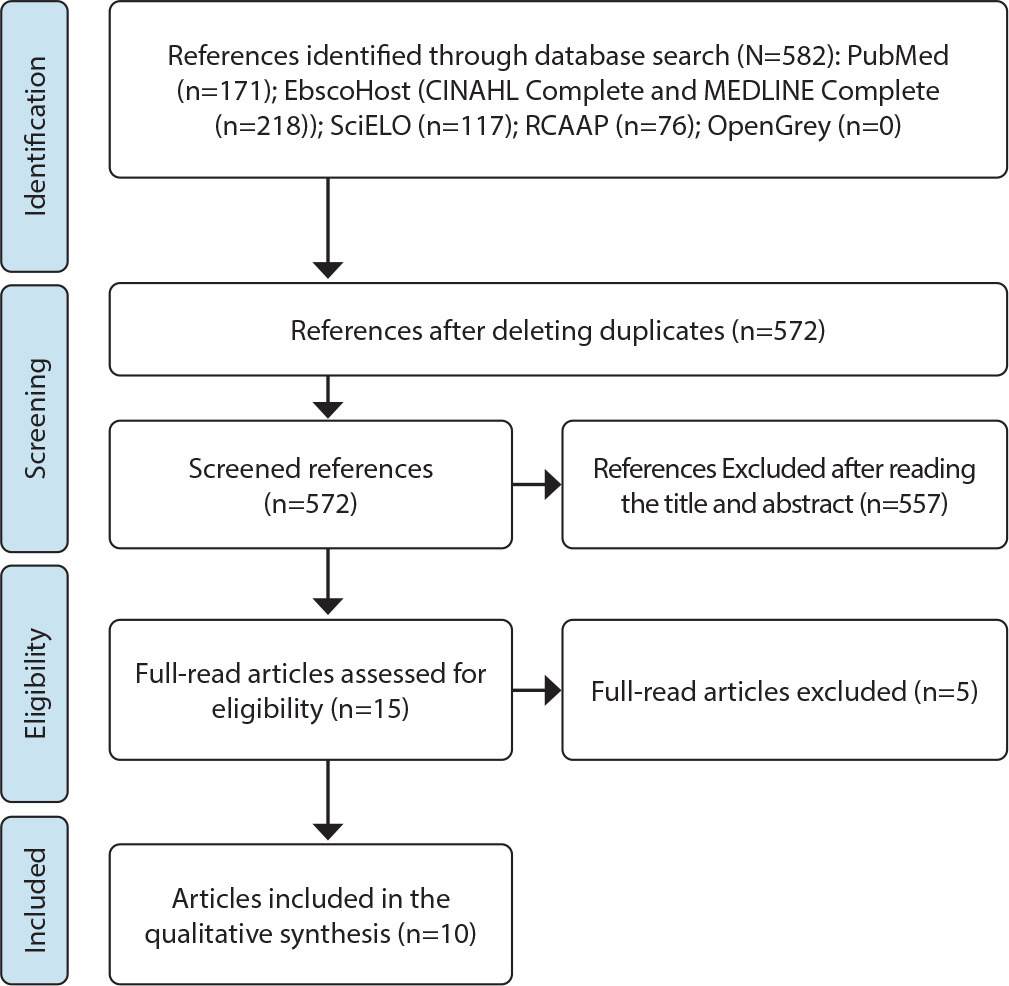
-
ARTÍCULO ORIGINAL22/11/2024
Prevalence of prescription and effectiveness of analgesia for treating vaginal delivery pain
Revista Brasileira de Enfermagem. 2024;77(5):e20230327
Resumen
ARTÍCULO ORIGINALPrevalence of prescription and effectiveness of analgesia for treating vaginal delivery pain
Revista Brasileira de Enfermagem. 2024;77(5):e20230327
DOI 10.1590/0034-7167-2023-0327
Visualizações0Ver maisABSTRACT
Objectives:
to assess pain management during labor.
Methods:
a cross-sectional study was carried out by reviewing medical records and conducting postpartum interviews. Prevalence and effectiveness of analgesia were assessed.
Results:
the prevalence of non-pharmacological analgesia was 61.86% of 215 women in labor in Obstetric Center and 82.51% of 62 in midwife-led unit. Prevalence of severe pain, on the Visual Analogue Scale, before and after non-pharmacological analgesia, was from 92.16% to 64.04% (p=0.00) in Obstetric Center and from 85.96% to 52.63% (p=0.01) in midwife-led unit. Prevalence of pharmacological analgesia in Obstetric Centers was 15.81%, with no variation in severe pain (p=0.57). Patients’ request for analgesia was associated with education (p=0.00) and pain intensity (p=0.02).
Conclusions:
non-pharmacological analgesia improved pain intensity. Prevalence of pharmacological analgesic prescription was lower than that identified in developed countries. Pain management needs to consider the preferences and needs of women in labor.
-
22/11/2024
Social Technology in the Prevention of Adolescent Violence: documentary production
Revista Brasileira de Enfermagem. 2024;77(5):e20230298
Resumen
Social Technology in the Prevention of Adolescent Violence: documentary production
Revista Brasileira de Enfermagem. 2024;77(5):e20230298
DOI 10.1590/0034-7167-2023-0298
Visualizações0Ver maisABSTRACT
Objective:
To report the development of a technological innovation in the form of a documentary, aimed at disseminating actions for preventing violence against adolescents within the context of Primary Health Care.
Methods:
The documentary was developed through action research and interventions with adolescents in the territory of a Health Unit, conducted between 2020 and 2022, using Social Technology as both an action strategy and a conceptual reference.
Results:
The Social Technology proposal, created through workshops and seminars, resulted in a documentary focusing on violence prevention, involving 48 adolescents. The documentary’s script, collectively developed, portrays a soccer match between teams symbolizing peace and violence, with peace ultimately prevailing. The documentary is six minutes long.
Final Considerations:
The documentary has proven to be an effective Social Technology tool among adolescents, as it fosters critical thinking, is accessible, has potential for digital dissemination, and appeals to the target audience.
-
ARTÍCULO ORIGINAL22/11/2024
Study for the validation of evaluation indicators of electronic health records in immunization: Delphi technique
Revista Brasileira de Enfermagem. 2024;77(5):e20230112
Resumen
ARTÍCULO ORIGINALStudy for the validation of evaluation indicators of electronic health records in immunization: Delphi technique
Revista Brasileira de Enfermagem. 2024;77(5):e20230112
DOI 10.1590/0034-7167-2023-0112
Visualizações0Ver maisABSTRACT
Objective:
To develop and validate indicators for the evaluation of computerized systems in vaccination rooms.
Methods:
Methodological study. From the construction of a logical model for managing information produced in computerized systems in vaccination rooms, an evaluation indicator matrix was developed, and its contents were validated by specialists using the Delphi method. The degree of relevance and clarity were judged, using the following parameters: agreement percentage ≥ 90%; content validity index > 0.78. Internal consistency was tested using Cronbach’s alpha coefficient of 0.93.
Results:
Of the 55 proposed indicators, 48 were validated and composed the final matrix, with 13 in the structure dimension, 29 in the process dimension, and six in the outcome dimension.
Conclusion:
The set of indicators shows validity and high reliability, and can be used to evaluate computerized systems in vaccination rooms throughout the country, as it adhered to the recommendations of the National Immunization Program.
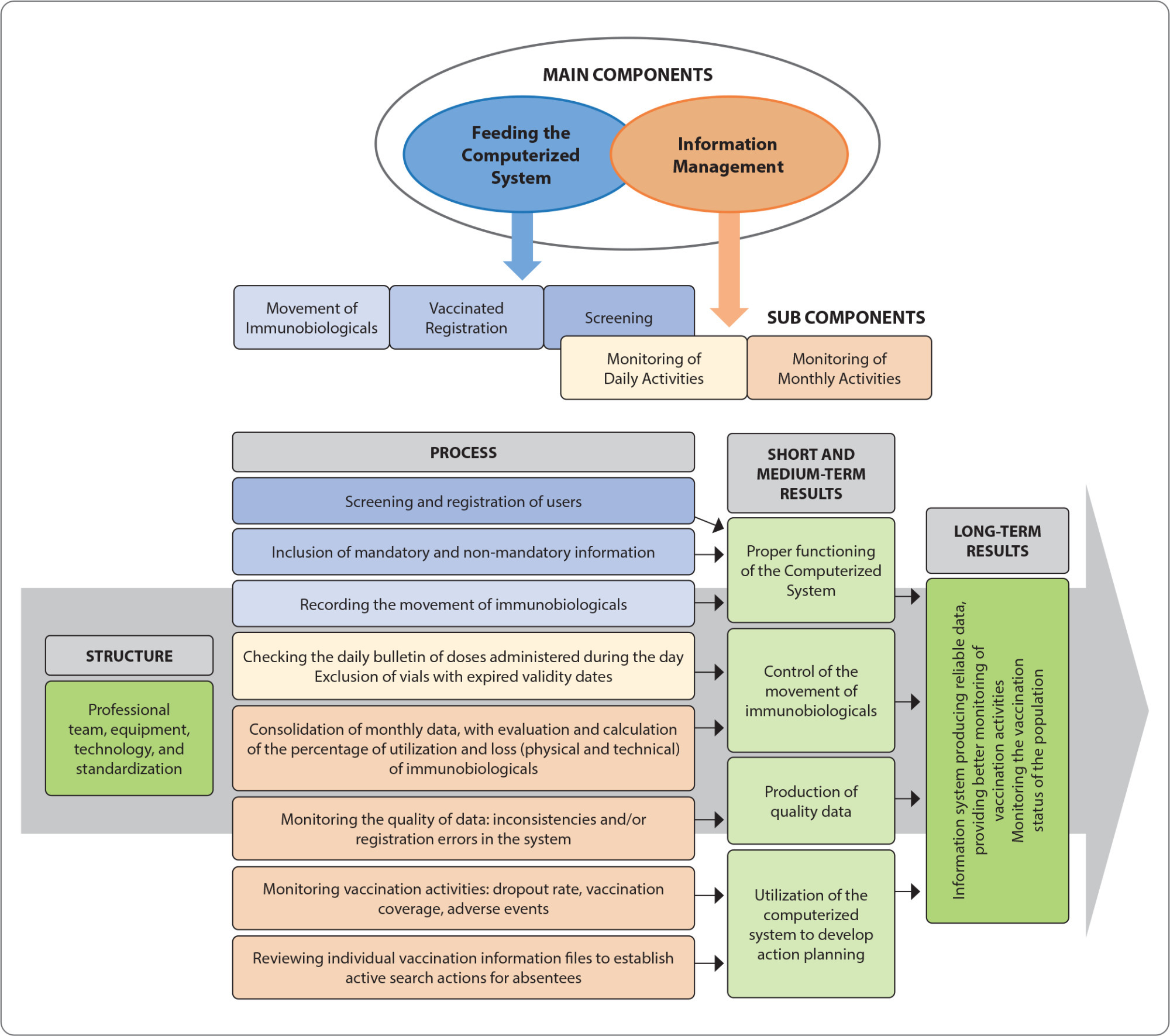
-
22/11/2024
Rondas a beira leito no ambiente hospitalar na perspectiva de equipes multiprofissionais de saúde
Revista Brasileira de Enfermagem. 2024;77(5):e20230493
Resumen
Rondas a beira leito no ambiente hospitalar na perspectiva de equipes multiprofissionais de saúde
Revista Brasileira de Enfermagem. 2024;77(5):e20230493
DOI 10.1590/0034-7167-2023-0493
Visualizações0Ver maisRESUMEN
Objetivo:
Analizar la configuración de las relaciones de poder entre el equipo multiprofesional en el proceso de rondas de cabecera en el hospital.
Método:
Investigación cualitativa con datos analizados a través del análisis del discurso, basado en el marco teórico de Michel Foucault. De septiembre a diciembre de 2022, realizamos entrevistas y observaciones de campo con el equipo multiprofesional de un hospital de Belo Horizonte, Minas Gerais, Brasil, así como entrevistas cualitativas semiestructuradas con 37 profesionales.
Resultados:
Los participantes señalaron que las experiencias de los profesionales involucrados en las rondas de cabecera dependen de cómo el médico conduce el proceso, y el proceso centrado en el médico dificulta la participación de otros profesionales del equipo.
Consideraciones finales:
La forma en que los hospitales organizan las rondas de cabecera no promueve la articulación del conocimiento de sus profesionales. Además, dificulta la circulación del poder y perjudica el trabajo interdisciplinario en un proceso que mantiene al médico como actor principal de las decisiones clínicas.
-
ARTÍCULO ORIGINAL22/11/2024
Knowledge sharing: nurse managers’ practices
Revista Brasileira de Enfermagem. 2024;77(5):e20230287
Resumen
ARTÍCULO ORIGINALKnowledge sharing: nurse managers’ practices
Revista Brasileira de Enfermagem. 2024;77(5):e20230287
DOI 10.1590/0034-7167-2023-0287
Visualizações0Ver maisABSTRACT
Objective:
To analyze how management practices for sharing knowledge are developed in public hospitals in the context of nursing.
Methods:
Qualitative research, carried out with 15 nurse managers from six public hospitals, from July to September 2022. Data were collected through semi-structured interviews and analyzed according to content analysis and in a model for sharing knowledge at work.
Results:
Knowledge sharing in nursing occurs through intraand extra-organizational training (training, courses and events), use of digital communication tools (media and social networks) and individual and collective contact between professionals during the service (experiences, exchange of experiences and assessment feedback).
Final considerations:
Sharing knowledge is relevant to nursing work. To improve it, it must be understood that effective sharing occurs from person to person, in their daily practices, and must be conducted as a strategically planned process by nurse managers.
-
ARTÍCULO ORIGINAL22/11/2024
Interpersonal violence in the state of Espírito Santo: analysis of mandatory notifications between 2011 and 2018
Revista Brasileira de Enfermagem. 2024;77(5):e20230081
Resumen
ARTÍCULO ORIGINALInterpersonal violence in the state of Espírito Santo: analysis of mandatory notifications between 2011 and 2018
Revista Brasileira de Enfermagem. 2024;77(5):e20230081
DOI 10.1590/0034-7167-2023-0081
Visualizações0Ver maisABSTRACT
Objective:
To identify the frequency of notifications of interpersonal violence in Espírito Santo from 2011 to 2018, and the factors associated with this issue.
Methods:
This is a cross-sectional study in which all cases of interpersonal violence from the Information System for Notifiable Diseases in the state of Espírito Santo during the period from 2011 to 2018 were analyzed. Absolute and relative frequencies and 95% confidence intervals were calculated, as well as Poisson regression.
Results:
During the analyzed period, 27,277 cases were reported in Espírito Santo (P: 75%; 95% CI: 74.5-75.4), being more prevalent among females, children, and the elderly, individuals of black/mixed race, people without disabilities, and residents of urban areas. Regarding the perpetrator, there was a higher prevalence of individuals aged 25 years and older, males, with a current or former intimate partner relationship with the victim, and suspected alcohol use at the time of the aggression. In terms of the characteristics of the aggression, there was a higher prevalence of repeat violence, involving a single aggressor, and occurring in the residence.
Conclusions:
The notification of interpersonal violence in Espírito Santo showed a high prevalence and was associated with characteristics of the victim, aggressor, and event. This scenario reinforces the need for interventions such as professional qualification, expansion of intersectoral actions, and reformulation of public policies.
-
ARTÍCULO ORIGINAL19/08/2019
Virtual learning object in hematopoietic stem cell transplantation for autoimmune diseases
Revista Brasileira de Enfermagem. 2019;72(4):994-1000
Resumen
ARTÍCULO ORIGINALVirtual learning object in hematopoietic stem cell transplantation for autoimmune diseases
Revista Brasileira de Enfermagem. 2019;72(4):994-1000
DOI 10.1590/0034-7167-2018-0669
Visualizações0Ver maisABSTRACT
Objective:
describe the development of a virtual learning object to provide information about autologous transplantation of hematopoietic stem cells to autoimmune diseases.
Methods:
methodological study of a website development, using the instructional design model that includes Analysis, Design, Development and Implementation.
Results:
the virtual object, available at , was developed in a web platform, in the Hypertext Markup Language, using the software WebAcappella – Responsive Website Creator (Intuisphere, France 2016). The content was structured in the modules: History, Transplant, Autoimmune Diseases, Links, Guidelines, Speech Team and Doubts. The icons and menus were created in order to attract the user, facilitating the search for information and allowing maximum use of the resources available on the website.
Conclusion:
the methodology used allowed the development of the virtual learning object, which can be used as a tool to guide and disseminate knowledge about this treatment.
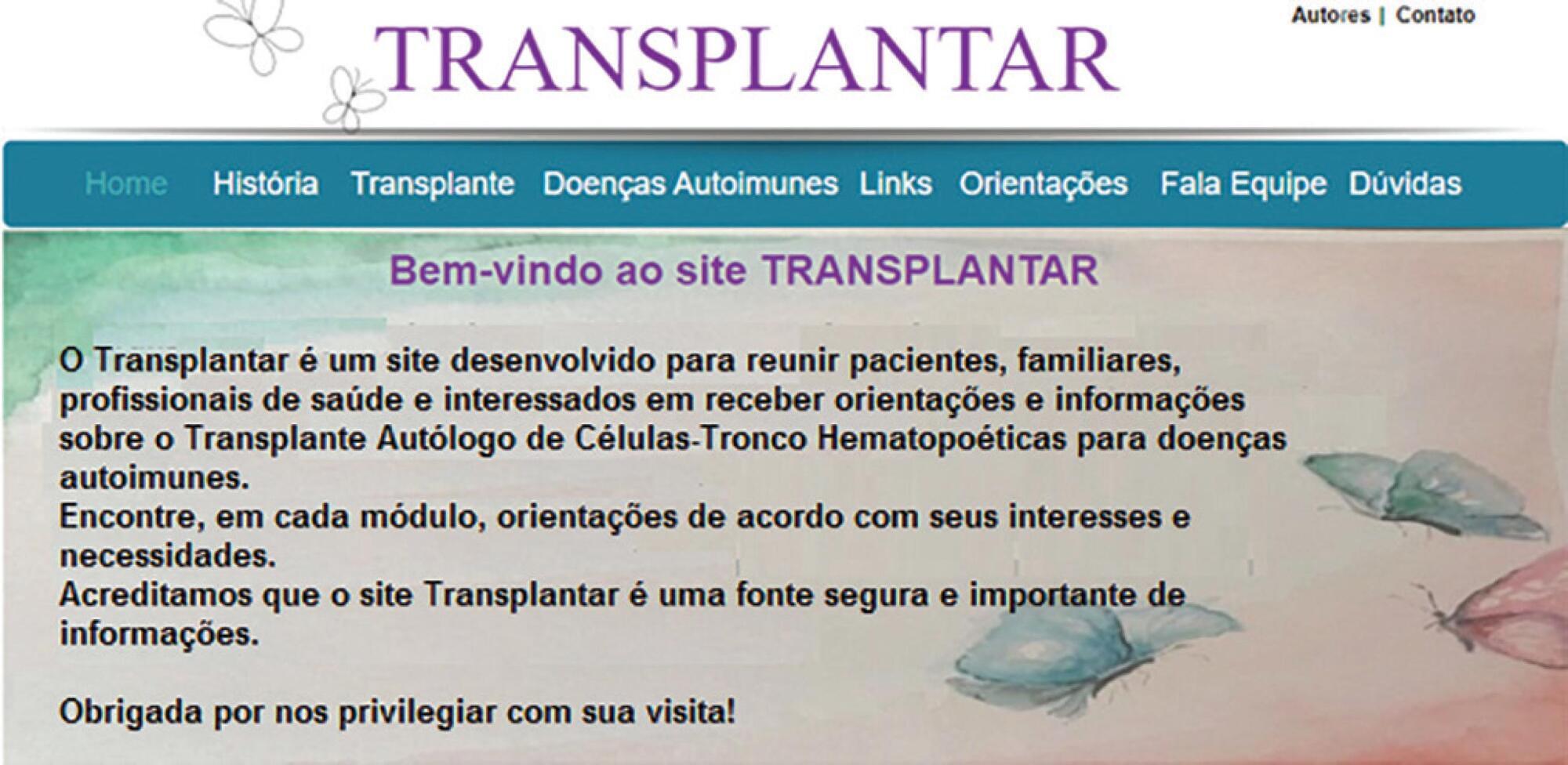
-
ESTUDIO DE CASO19/08/2019
Self-determination, emotions and exclusion in a blog of deaf people: a qualitative perspective
Revista Brasileira de Enfermagem. 2019;72(4):1094-1101
Resumen
ESTUDIO DE CASOSelf-determination, emotions and exclusion in a blog of deaf people: a qualitative perspective
Revista Brasileira de Enfermagem. 2019;72(4):1094-1101
DOI 10.1590/0034-7167-2018-0573
Visualizações0Ver maisABSTRACT
Objective:
to explore the deaf people’s perceptions about their well-being, published on a weblog.
Method:
A free access spanish blog that’s been created and used by deaf people is selected. Under qualitative methodology with a phenomenological approach, through the non-participating and asynchronous observation, sign language speeches are analyzed in 44 video messages uploaded by deaf bloggers.
Results:
in the speeches analyzed, inclusion’s areas cited the most are self-determination, social inclusion and emotional well-being, these latter two in a negative way: social exclusion and emotional distress.
Final considerations:
The study participants state that the arrangements adopted for their inclusion are not enough, with feelings of discomfort prevailing in all areas and life stages. Solidarity initiatives, elimination of communication barriers and true transforming agents of our society are needed.
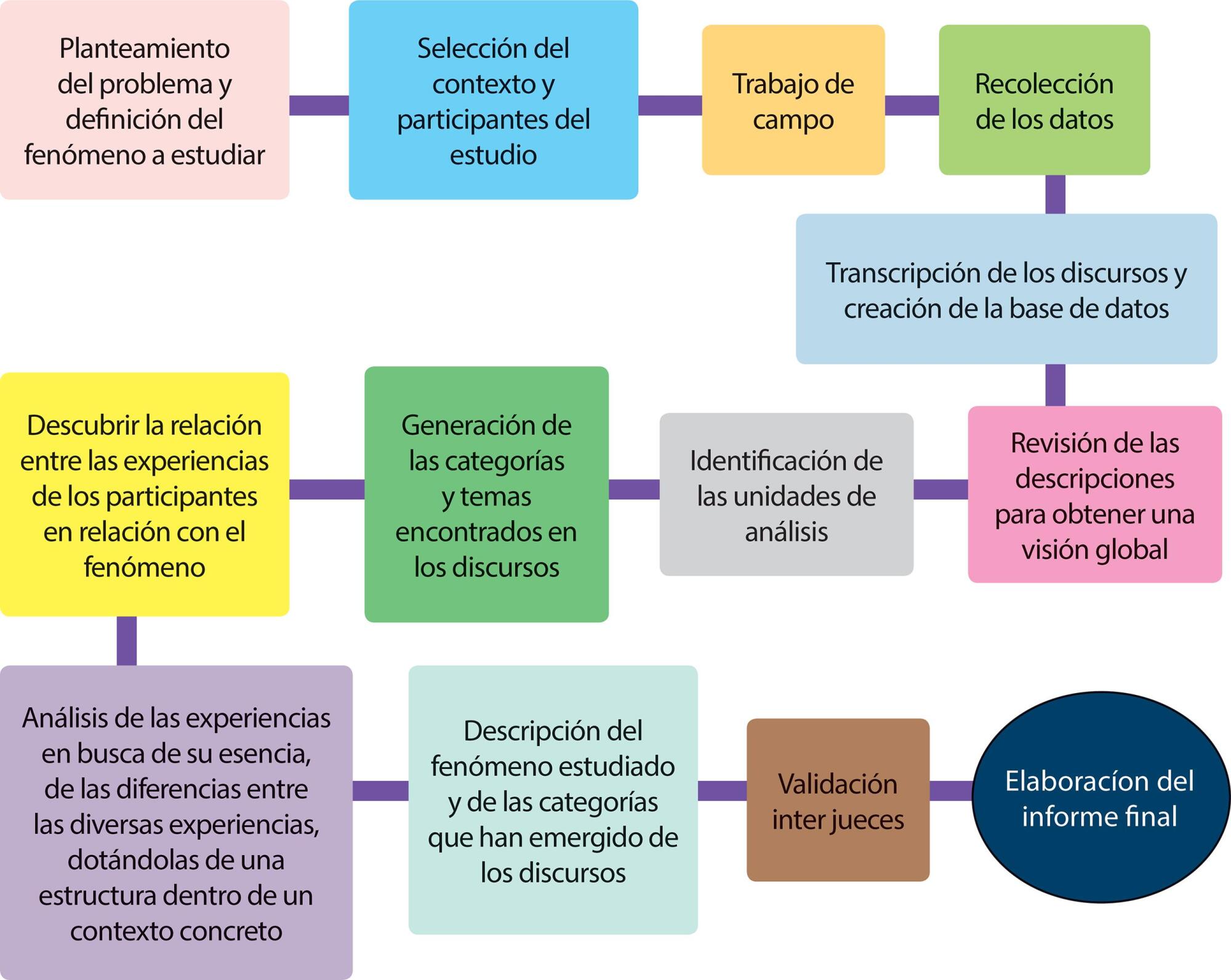
-
ARTÍCULO ORIGINAL16/09/2019
Aplicativo de mensagens instantâneas no cuidado às pessoas vivendo com HIV/aids
Revista Brasileira de Enfermagem. 2019;72(5):1161-1166
Resumen
ARTÍCULO ORIGINALAplicativo de mensagens instantâneas no cuidado às pessoas vivendo com HIV/aids
Revista Brasileira de Enfermagem. 2019;72(5):1161-1166
DOI 10.1590/0034-7167-2017-0698
Visualizações0Ver maisRESUMO
Objetivo:
Avaliar o aplicativo de mensagens instantâneas como ferramenta de cuidado às pessoas vivendo com HIV/aids, a partir da análise das interações entre enfermeiro e pacientes.
Método:
Estudo descritivo, quantitativo com 102 pacientes de dois ambulatórios de infectologia de Fortaleza, Ceará. Durante quatro meses, os participantes receberam uma mensagem a cada 15 dias, totalizando oito mensagens, sobre: adesão à terapia antirretroviral; atividade física; apoio social; autoestima; ansiedade/depressão; hábitos alimentares; álcool e drogas; e sexualidade.
Resultados:
Houve 816 interações, com destaque para os diálogos sobre realização de atividade física (27,87%), compartilhamento de sinais e sintomas (18,03%), relato de engajamento com o tratamento (9,84%) e requisição de informações sobre tomada de medicamentos (9,84%). A maioria dos participantes demonstrou satisfação com o acompanhamento, com desejo de continuar recebendo as mensagens (90,58%).
Conclusão:
O uso desse aplicativo é uma estratégia viável para incrementar o cuidado às pessoas com HIV, por promover comunicação instantânea.
-
INFORME DE EXPERIENCIA16/09/2019
Educational workshop with adolescents on leprosy: case report
Revista Brasileira de Enfermagem. 2019;72(5):1421-1425
Resumen
INFORME DE EXPERIENCIAEducational workshop with adolescents on leprosy: case report
Revista Brasileira de Enfermagem. 2019;72(5):1421-1425
DOI 10.1590/0034-7167-2017-0663
Visualizações0Ver maisABSTRACT
Objective:
To report the experience of professors and students in the development and implementation of an educational workshop on leprosy with adolescents. Method: This is a case report from actions contained in a university extension project.
Results:
The workshop program was elaborated with duration of two hours, including five dynamic techniques adapted to the topic: adjective, face, traffic light, true or false and mosaic. It was verified that the construction of knowledge in light of the verbalization of the adolescents and the interest in working in the society they live through sharing this knowledge, especially those who were more involved in the process.
Conclusion:
It was concluded that the applied workshops enabled building knowledge and demystifying myths and stigmas socially constructed to adolescents, as well as allowed Nursing students to experience educational interventions on leprosy with adolescents.
-
ARTÍCULO ORIGINAL21/10/2019
Significados atribuídos por familiares e pacientes à presença da família em emergências
Revista Brasileira de Enfermagem. 2019;72(6):1684-1691
Resumen
ARTÍCULO ORIGINALSignificados atribuídos por familiares e pacientes à presença da família em emergências
Revista Brasileira de Enfermagem. 2019;72(6):1684-1691
DOI 10.1590/0034-7167-2018-0814
Visualizações0Ver maisRESUMO
Objetivo:
compreender o processo que leva pacientes adultos e familiares a apoiarem a presença da família no atendimento emergencial.
Método:
estudo qualitativo que adotou o Interacionismo Simbólico como referencial teórico e a Teoria Fundamentada nos Dados como referencial metodológico. A amostragem teórica foi composta por 15 familiares e 15 pacientes atendidos em duas unidades emergenciais no Sul do Brasil. Os dados foram analisados por meio de codificação aberta, axial e seletiva.
Resultados:
a categoria central “Convergência de ideias: familiares e pacientes apoiando a presença da família no atendimento emergencial” é sustentada pelas categorias: “Afetuosa relação entre os membros da família”; “Obrigação tácita de cuidar do familiar enfermo”; “Benefícios para a família”; “Benefícios para o paciente”; e “Benefícios para a equipe de saúde”.
Conclusão:
a presença familiar no atendimento emergencial proporciona a manutenção e o fortalecimento dos laços afetivos entre os familiares e a vivência de cuidados mais sensíveis e qualificados.
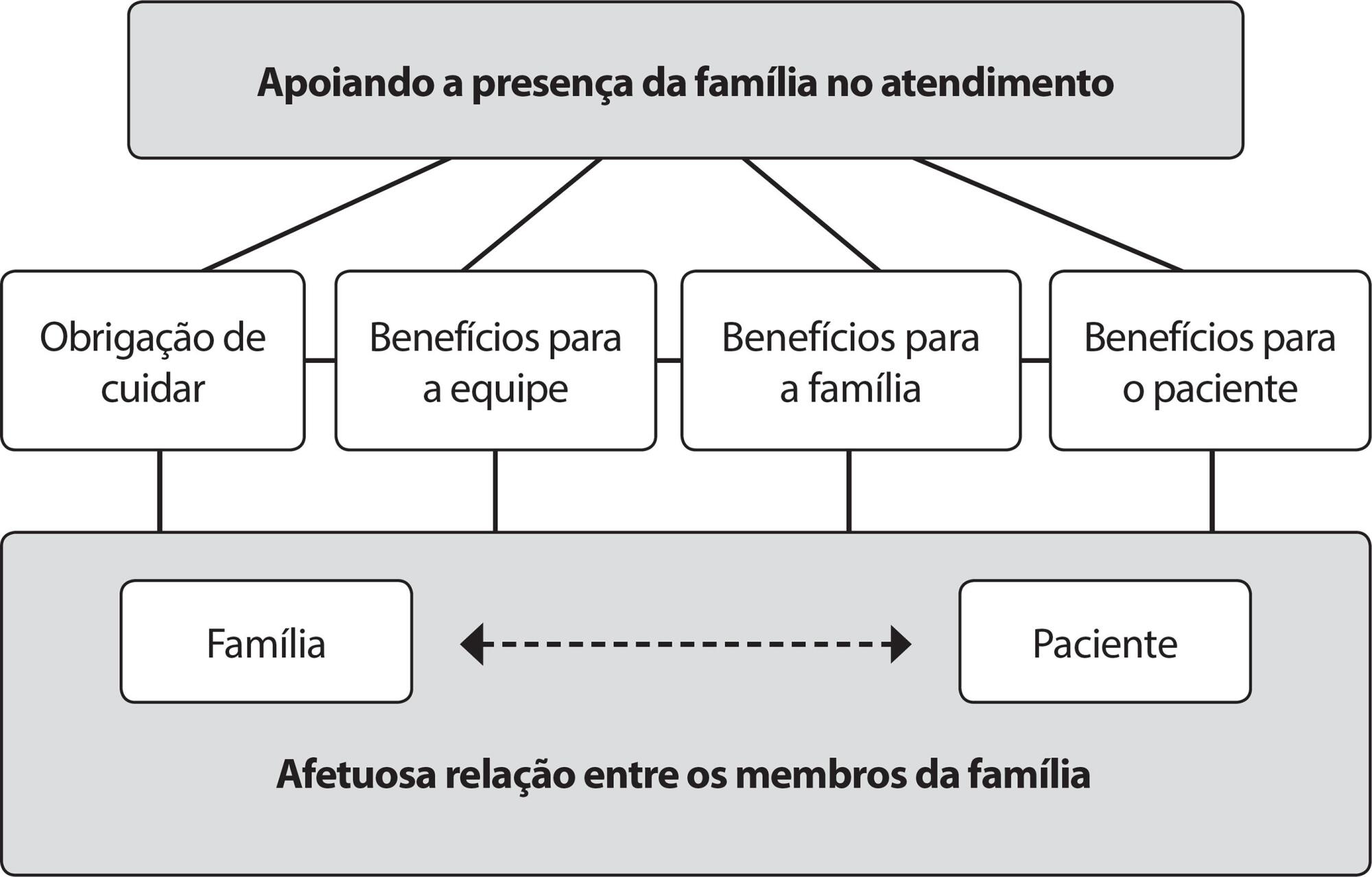
-
ARTÍCULO ORIGINAL05/12/2019
O mercado de trabalho em enfermagem gerontológica no Brasil
Revista Brasileira de Enfermagem. 2019;72:97-103
Resumen
ARTÍCULO ORIGINALO mercado de trabalho em enfermagem gerontológica no Brasil
Revista Brasileira de Enfermagem. 2019;72:97-103
DOI 10.1590/0034-7167-2018-0178
Visualizações0Ver maisRESUMO
Objetivo:
analisar o desenvolvimento do mercado de trabalho na Enfermagem Gerontológica brasileira, entre 1970 e 1996.
Método:
estudo descritivo-qualitativo, com abordagem histórica, que utiliza a história oral de 14 enfermeiras pesquisadoras atuantes no período histórico, fundamentada nas ideias de Eliot Freidson.
Resultados:
a Enfermagem venceu barreiras para a transformação das práticas do cuidado ao idoso no período descrito, considerando a inexistência de mercado de trabalho específico; necessidade de conhecimento teórico para o atendimento em Gerontologia; a escassez de pesquisas e pesquisadoras na área; o surgimento do cuidador de idosos; a construção da multidisciplinaridade e a transformação das instituições de longa permanência.
Considerações finais:
a expansão do mercado de trabalho na época foi fundamentada por avanços na produção do conhecimento sobre o processo de envelhecimento, respaldado pela transição demográfica, que determinou o aumento na demanda de idosos nos serviços de saúde e a promulgação de leis específicas de proteção aos idosos.
-
ARTÍCULO ORIGINAL05/12/2019
Evaluation of elderly care dynamics in an emergency care unit
Revista Brasileira de Enfermagem. 2019;72:161-168
Resumen
ARTÍCULO ORIGINALEvaluation of elderly care dynamics in an emergency care unit
Revista Brasileira de Enfermagem. 2019;72:161-168
DOI 10.1590/0034-7167-2018-0401
Visualizações0Ver maisABSTRACT
Objective:
understand elderly care dynamics of an emergency care unit.
Method:
this is a case study evaluation, using a qualitative approach and the theoretical-methodological reference of a fourth generation evaluation. Data collection was conducted between February and September 2017, through 460 hours of participant observation, interviews with 33 social actors among health professionals, elderly people and their relatives of an emergency care unit located in a municipality in the northwest of Paraná, as well as negotiation meetings with participants.
Results:
the evaluation showed the elderly care dynamics is mainly influenced by nursing actions that articulate care practices based on priority, frailty, autonomy, independence and family context of the elderly patients.
Final considerations:
an evaluation of how the emergency care unit operates helps improve elderly care in urgent and emergency services.

-
ARTÍCULO ORIGINAL05/12/2019
Translation and content validation of the Geriatric Institutional Assessment Profile for Brazil
Revista Brasileira de Enfermagem. 2019;72:205-213
Resumen
ARTÍCULO ORIGINALTranslation and content validation of the Geriatric Institutional Assessment Profile for Brazil
Revista Brasileira de Enfermagem. 2019;72:205-213
DOI 10.1590/0034-7167-2018-0602
Visualizações0Ver maisABSTRACT
Objective:
to describe the process of content adaptation and validation of the Geriatric Institutional Assessment Profile (GIAP) for nurses working in the health care for older adults in Brazilian hospitals.
Method:
methodological study conducted in five stages: initial translation, synthesis of initial translation, back translation, evaluation by committee of judges, and pre-test for cultural adaptation of the instrument.
Results:
the instrument evaluation had good agreement between the judges, with general content validity of 0.94. The items of the translated version evaluated as unsatisfactory by the judges were reformulated from the professionals’ considerations in each group. Thirty-one subjects participated in the study. They considered the instrument easy-to-understand and suggested minor adjustments in some items.
Conclusion:
the content of the Brazilian version of the GIAP is considered adapted and validated, with potential use in hospital institutions. The next stage will be to submit the instrument to the evaluation process of its psychometric properties for use in Brazilian populations.
Búsqueda
Buscar en:
Nuvem de Tags
Adolescente (85) Atenção Primária à Saúde (239) COVID-19 (91) Criança (91) Cuidados de Enfermagem (269) Educação em Enfermagem (151) Educação em Saúde (139) Enfermagem (930) Enfermagem Pediátrica (86) Estudantes de Enfermagem (77) Estudos de Validação (131) Família (87) Idoso (208) Promoção da Saúde (99) Qualidade de Vida (104) Saúde do Trabalhador (86) Saúde Mental (145) Saúde Pública (82) Segurança do Paciente (150) Tecnologia Educacional (100)



